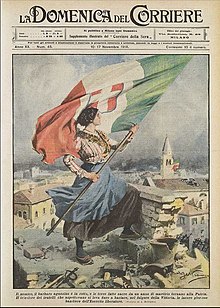La Leggenda del Piave
| English: The Legend of Piave | |
|---|---|
 A woman, representing Italy, celebrates the Italian victory over Austria-Hungary in the First World War with a tricolour over the newly conquered city of Trieste. | |
National anthem of Kingdom of Italy | |
| Lyrics | E. A. Mario, 1918 |
| Music | E. A. Mario, 1918 |
| Adopted | September 1943 |
| Relinquished | June 1944 |
| Preceded by | "Marcia Reale" (1943) |
| Succeeded by | "Marcia Reale" (1944) |
"La Leggenda del Piave" (lit. 'The Legend of Piave'), also known as "La Canzone del Piave" (lit. 'The Song of Piave'), is an Italian patriotic song written by E. A. Mario after the Second Battle of the Piave River in June 1918. In September 1943, the future king of Italy Umberto II chose it as the new national anthem, replacing the "Marcia Reale". It remained the official anthem of Italy until June 1944; when Rome was liberated and the government and the King returned to the capital, the "Marcia Reale" was reintroduced as a national anthem and remained both after the appointment of Crown Prince Umberto of Savoy as Lieutenant General of the Realm and after his elevation to King. After the 1946 Italian institutional referendum, the newly established Italian Republic selected "Il Canto degli Italiani" in its stead. Today, the song is popular in Italy and played by a military band on National Unity and Armed Forces Day (November 4).
Text
[edit]The song is divided in four parts and presents a brief history of the Italian front during World War I.
- The march of the Italian army in May 1915 from Veneto to the frontline.
- The Italian defeat at Caporetto.
- The resistance along the Piave River.
- The final battle at Vittorio Veneto and the victory.
Lyrics
[edit]| Italian[1] |
|---|
| Il Piave mormorava Calmo e placido al passaggio Ma in una notte trista E ritornò il nemico Indietreggiò il nemico |
Impact
[edit]The song was executed for the first time at the end of the battle held on June 23, 1918. General Armando Diaz addressed a personal telegram to the author to thank him for his musical contribution to the military victory of the Italian army.[2]
In the years following World War I, the song became an anthem dedicated to the resistance during the war.
E. A. Mario refused to gain money from "La Leggenda del Piave". In November 1941, he donated his and his wife's wedding rings along with the first 100 gold medals he received as a tribute for this song by the towns along the river Piave, war veterans' associations, and private citizens to the "Gold for the Fatherland" initiative.[3]
"La Leggenda del Piave" was one of the candidates to become the anthem of the new Italian Republic. However, "Il Canto degli Italiani" was chosen instead.
Today, "La Leggenda del Piave" is still widely popular and is commonly played during official ceremonies to remember the fallen and the final victory.
References
[edit]- ^ "Italian Songs - Texts - La leggenda del Piave". www.napule-de-canzone.com. Retrieved 2023-08-07.
- ^ "Il 24 maggio 1915 per l'Italia cominciava la prima guerra mondiale. La canzone del Piave del fratello E.A Mario immortalò quel momento". Grand Orient of Italy (in Italian). 24 May 2020.
- ^ "Il Cerchio", by Franz Maria D'Asaro
External links
[edit]- [1] played by Giovanni Martinelli (1918)
